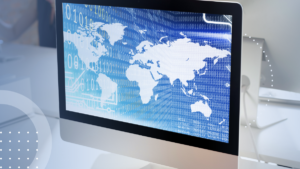Una herramienta para el crecimiento empresarial:
¿qué es una memoria de traducción?

In this hyper-connected world, which uses technology to improve life standards and work efficiency, the translation industry isn’t left out. Therefore, to answer the question of “what is a translation memory?” in a few words, it’d suffice to say that it’s a crucial tool for professional linguists and businesses that aim to obtain high-quality translated documents.
But if we want to be fair, it’s more than just that; a translation memory is a powerful technological feature that has revolutionised the field of translation. And it arrived at the right time: When the demand for translation and localisation services to scale up a business is only increasing.
In this article, we’ll explore what translation memory is, how it works, and its benefits. Whether you’re a small business owner, a partner in a medium-sized enterprise, or an employee in a multinational, you’ll find that international expansion is just a few clicks away. Yet, in that quest, accurate translations can open the way for you by leveraging this unique tool.
¿qué es una memoria de traducción?
Let’s give the issue some context.
In the past, when linguists had to work on long documents or on any type of material with repeated content, they had to translate those recurring passages again and again by hand. As you can imagine, this can easily lead to inconsistencies and errors, since we are only humans.
Then, translation memory (or TM, to make it short) came to the scene, as a key feature of modern computer-assisted translation tools. The TM is a database that stores previously translated segments of text. It’s a type of software that helps translators to maintain consistency and accuracy in their translations and, therefore, to ensure top quality.
As a side benefit, expert linguists can save a lot of time and effort, which leads to more focused work on the document’s purpose and potential cost reductions for you. Simply put: “What is a translation memory?” can also be answered as a tool to get your translated content faster and more cost-efficiently.
Learn more about computer-assisted translation (or CAT) tools with our free webinar.
#OptimationalTip: Translation memory software saves the translated texts in a database, making it easy for professional linguists to retrieve and reuse them in future projects.
How Does It Work?
The TM breaks down the text into smaller segments, usually sentences or phrases, and stores them in a database. When human translators start working on a new project, the software searches for matching segments in the database. If a matching segment is found, the translators can reuse it—here’s the part of saving time and effort.
Another good news is that the tool is constantly expanding and evolving; the software updates the database on an ongoing basis, adding new translations made by your linguist partner automatically.
But wait, there’s more. TM software can also be programmed to recognize different text types, such as technical manuals or legal documents. This feature ensures that the translation is appropriate for the text type, which takes accuracy and consistency to the next level. Plus, it makes it possible for you to really envision the longed-for global reach.
Benefits of Using a Translation Memory
From what we’ve said, you already have an idea of the advantages. However, since the question of what a translation memory is can also be answered by the benefits it brings, we want to dive deep into this matter. So, here we list the key ones—so as not to leave this issue with a half-answer.
- Consistency: Translation memory guarantees that all translation projects are coherent, regardless of the human translator working on the project. This benefit is vital for companies that wish to maintain a strong brand identity across all their markets and channels.
- Time-saving: TM software saves time by allowing translators to reuse segments; it speeds up the process since they don’t have to spend time re-doing something that’s already done. Therefore, it’s easier to meet deadlines, and you can get an accurate translation as fast as it could be.
- Cost-effective: Using a TM is cost-effective for both customers and translation agencies. Clients benefit from reduced translation costs because the software reduces the time it takes to translate text. Translation companies can charge lower rates because the software makes the translation process more efficient.
- Increased quality: This is a result of better consistency and accuracy, but also of enabling the professionals to have more time to focus on what really matters. Plus, let’s not forget what we said about the text type—this helps to improve the readability of the translation.
- Improved workflow: In international business management, a seamless workflow is key. Therefore, for projects with global reach, it’s essential to follow a carefully developed plan. And TM is also great for that: It streamlines the process, making it more efficient and reducing the risk of errors.
#OptimationalTip: What is a translation memory? It’s a tool to streamline the translation process, improve time and resource management, and achieve high-quality translations.
How a Translation Memory Can Improve Translation Quality
The benefits mentioned in the previous segment are more than enough to appreciate what TM can do to improve the translation process. However, we can also analyse another angle: That of the specific attributes the tool enables to emerge. Let’s see.
- Customisation: In general, computer-assisted translation tools have customisable features to suit the needs of individual clients, and this goes for TM as well. The software can be programmed to recognise specific terminology and industry jargon, which ensures that the translations are appropriate for the target audience.
- Quality assurance: TM is one of the key tools in quality control, along with others such as Xbench, Verifika, etc. It can compare a new translation with previous similar versions and identify inconsistencies or mistakes. A must if you have a writing guide, brand manual, or translation guidelines and want to preserve your business voice and tone.
- Collaboration: As for what a translation memory is, we can’t fail to mention that it’s a tool that can be used to facilitate cooperation between linguists assigned to the same project. The software allows multiple professionals to work hand in hand, ensuring that the project outcome will remain consistent and the process, optimised.
- Terminology management: The core aspect and ultimate function of a TM is to bring together terms and lexicon in a database so that linguists can manage it across multiple projects. It’s paramount that the tool supports the updating, adding or editing of terminology and that all of these can happen anytime.
#OptimationalTip: It’s possible to have many TMs, even for working on projects for the same client (aiming to scale up their business.) In this way, the translators can choose the memory that best suits the specifications of a target audience and deliver a fully localised text.
Last Thoughts on What a Translation Memory Is
As we’ve seen, there are many ways of defining what a TM is, without falling into the simple (but correct]) definition of “it’s a tool to assist and optimise the translation process.”
The truth is, the rich set of benefits the tool has makes it a bit unfair to define it only as a technological feature; that’s why it’s necessary to define its applicability and how it works to better understand the scope of the TM while enabling you to foresee how it can support you.
After all, international business management requires workflow efficiency, time, cost and resource planning, and assertive decision-making. And isn’t that exactly what a TM has to offer you?
If you want to push your business forward and overcome the language barrier, contact us today. Let’s find out how we can help you.


